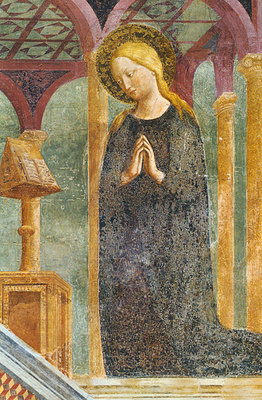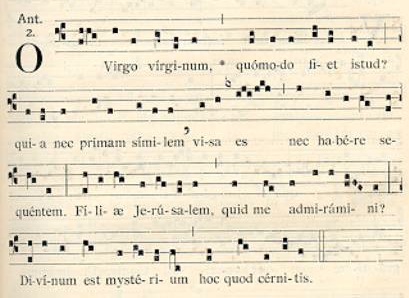Feast of the Expectation of the Blessed Virgin Mary

Yes, today, December 18th, is one of the liturgy’s loveliest old Advent festivals of the Blessed Virgin Mary, that of the Expectatio Partus. It was kept by nearly the entire Latin Church. The Marquess of Bute calls it, in his fine old translation of the Breviary, “The Blessed Virgin Mary Looking Shortly To Be Delivered.” It was also called in Spain, and elsewhere, Nuestra Señora de la O, and this because, after Vespers, the clergy in choir used to give voice to a loud and protracted “O” to express the yearning of the universe for the advent of the Redeemer.
Looking first at the Office for the feast, one discovers that the Invitatory Antiphon is the greeting of the Archangel to the Virgin of Nazareth: “Hail Mary, full of grace, * the Lord is with thee.” The antiphons on the psalms of Matins are all taken from the Advent Office. The lessons are Isaiah’s prophecy of the Virgin with Child (Is 7:10), a passage from Saint Ildephonsus of Toledo on the Maidenhood of Blessed Mary, and one from the Venerable Bede on the Annunciation Gospel. The final responsory is the glorious Fourth Mode Suscipe verbum, “Receive, O Virgin Mary, receive the word of the Lord, which is sent thee by His Angel.”
The Collect throughout the day is that of Lady Day in March:
O God who didst will that Thy Word should,
by the message of an Angel,
take flesh in the womb of the Blessed Virgin Mary,
grant unto us, we beseech Thee,
that all we who do believe her to be in very deed
the Mother of God,
may be holpen by her prayers in Thy sight.
At Lauds and the Hours, the antiphons are those of Lady Day, while the hymns remain those of the Advent Office. The Magnificat Antiphon is the lovely O Virgo Virginum, composed in the same Second Mode melody as the Great O Antiphons:

O maiden of maidens,
how shall this be,
since neither before nor henceforth hath there been,
nor shall be such another?
Daughters of Jerusalem,
why look ye curiously upon me?
What ye see is a mystery of God.
I would venture to suggest that the Office and Mass of the Expectation of the Blessed Virgin Mary are today, more than ever before, worthy of celebration and meditation, given that the perpetual virginity of the Mother of God is roundly mocked by many. Even in the minds of many of the faithful, enfeebled by a forty year dearth of popular orthodox catechesis, a tragic confusion holds sway concerning the privileges of the Blessed Virgin Mary and, in particular, her virginity before, during, and after childbirth. There are many, alas, who, affected by various mutations of creeping Nestorianism and Arianism, have no grasp of what it means to call the Blessed Virgin Mary, Mother of God. Those who do not confess the privileges of the Blessed Virgin Mary, honouring them and celebrating them, fall inevitably into one or another of the classic Christological heresies.
All of this makes me want to open my Processionale Monasticum to page 146 and sing, Gaude Maria, Virgo, cunctas haereses sola interemisti:
Rejoice, O Mary,
by whose mighty hand the Church hath victory
over her foes [every heresy] achieved,
since thou to Gabriel’s word of quickening power
in lowliness hast listened, and believed
— thou, still a virgin, in thy blessed womb
hast God Incarnate of thy flesh conceived,
and still, in heaven, of that virginity remainest
after childbirth unbereaved.
V. Blessed art thou that hast believed,
for there is a performance of those things
which were told thee from the Lord.

The lovely image of Our Lady of the O’s (Nuestra Señora de los Os) is also known in México where our Lady of Zapopan (in Guadalajara) is called with great affection by that same title. She is venerated by two feasts, one on October 12, and the other today, December 18th. Our Lady of the O’s is also venerated in Collinsville, Oklahoma, where a lovely statue of the Virgin was placed at the pinacle of the shrine there to St. Therese.